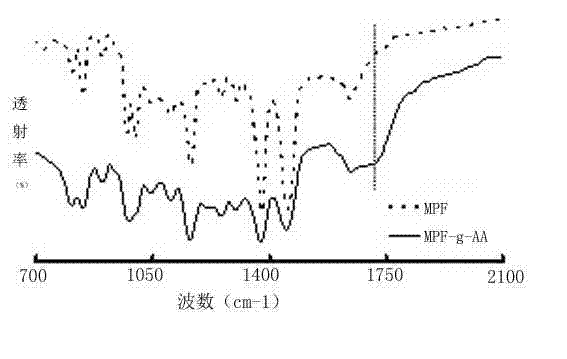Polypropylene industrial yarn cloth grafting modification method
A graft modification and industrial technology, applied in the field of chemical modification of polymer materials, can solve the problems that the hydrophilicity, dyeability and adsorption separation of fibers and fabrics are not significantly improved, so as to increase solubility and improve fluid mechanics volume effect
- Summary
- Abstract
- Description
- Claims
- Application Information
AI Technical Summary
Problems solved by technology
Method used
Image
Examples
Embodiment 1-9
[0044] Arrange polypropylene industrial yarns in xylene solutions with different photosensitizer contents and dip them in, so that the weight gain of industrial silk fabrics reaches a balance, and then take them out and dry them in the air. The so-called "weight gain reaches balance" means that the weight of industrial silk cloth hardly changes or changes little with the increase of soaking time. For better illustration, Figure 4 The weight gain of the polypropylene fabric is given when the photosensitizer concentration is 15wt% in xylene solution soaked for different times. The bath ratio is 5:1, and the maximum weight gain is nearly 20% when the immersion time is 1h, which means that the weight gain after soaking for 1h Reach balance. Polypropylene industrial silk cloth containing photosensitizer (pre-impregnation conditions: bath ratio 10:1, immersion time 10min) is subjected to electron beam irradiation treatment, the sample is placed on a dynamic conveyor belt with a sp...
Embodiment 10-15
[0050] The steps of Examples 10-15 are roughly the same as those of Examples 1-9, except that: (1), the polypropylene industrial silk cloth that has been pre-dipped (bath ratio 20:1, soaking time 5 minutes) is subjected to high-radiation radiation treatment , the effective irradiation rate is 3kGy / h; (2), in the grafting solution, the mass percentage of molar salt is 1wt%, the crosslinking agent is 10wt%, the neutralization degree of acrylic acid is 90mol%, and the total monomer concentration is 50v%, The liquor ratio is 5:1, and the soaking time is 35 minutes.
[0051] Table 3 lists the effects of high-energy ray pre-irradiation dose and photosensitizer concentration on grafting rate.
[0052] serial number Photosensitizer content (%) High-energy radiation dose (kGy) Grafting rate (%) Example 10 5 15 15.3 Example 11 10 25 17.8 Example 12 30 50 24.8 Example 13 5 75 22.7
[0053] Example 14 10 100 24.8 Examp...
Embodiment 16-24
[0058] The steps of Examples 16-24 are roughly the same as those of Examples 1-9, the difference is: (1) The polypropylene industrial silk cloth that has been pre-soaked (bath ratio 2:1, soaking time 50min) is subjected to plasma glow discharge treatment, the irradiation power is 300W, and the residual air pressure is 2000Pa; (2), in the grafting solution, the mass percentage of molar salt is 0.01wt%, the crosslinking agent is 1wt%, the degree of neutralization of acrylic acid is 5mol%, and the total monomer The concentration is 10v%, the liquor ratio is 20:1, and the immersion time is 60min.
[0059] Table 4 shows the effects of plasma glow discharge treatment time and photosensitizer concentration on the grafting rate of acrylic acid / sodium. It can be seen from Table 4 that the grafting rate increases with the increase of photosensitizer concentration and irradiation time.
[0060] serial number Photosensitizer content (%) Plasma glow discharge time (s) Graft...
PUM
| Property | Measurement | Unit |
|---|---|---|
| Areal density | aaaaa | aaaaa |
| Heat of fusion | aaaaa | aaaaa |
| Areal density | aaaaa | aaaaa |
Abstract
Description
Claims
Application Information
 Login to View More
Login to View More - R&D
- Intellectual Property
- Life Sciences
- Materials
- Tech Scout
- Unparalleled Data Quality
- Higher Quality Content
- 60% Fewer Hallucinations
Browse by: Latest US Patents, China's latest patents, Technical Efficacy Thesaurus, Application Domain, Technology Topic, Popular Technical Reports.
© 2025 PatSnap. All rights reserved.Legal|Privacy policy|Modern Slavery Act Transparency Statement|Sitemap|About US| Contact US: help@patsnap.com



